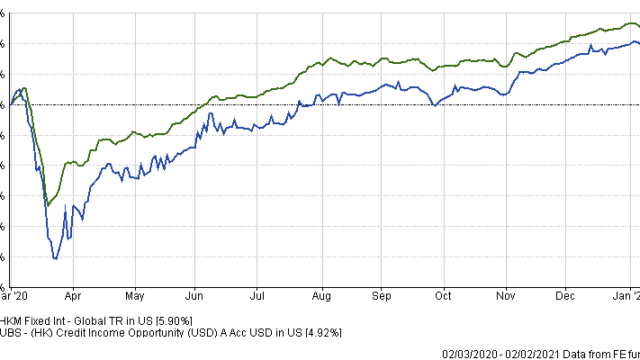The $229m UBS Credit Income Opportunity Fund was incepted in February 2020, but had only been available to professional investors in the territory.
Its authorisation by the Securities and Futures Commission (SFC) late last week means that the fund can now be distributed through bank outlets to retail buyers.
Potentially it also qualifies to be sold to Mainland China investors via the Mutual Recognition of Funds (MRF) scheme, because it is domiciled in Hong Kong, will soon have existed for one year, and is run by a team of Hong Kong-based managers, led by Hayden Briscoe – although UBS was unable to confirm any imminent plans before publication.
The fund has posted a 4.9% return since its launch on 28 February 2020, less than the average performance of other global fixed income products available to Hong Kong small investors, according to FE Fundinfo.
Its annualised volatility of 10.9% is greater than its peers (8.6%), and its high exposure to sub-investment grade credits as well as the timing of the initial launch — just three weeks before the pandemic-induced plunge in risk asset prices in mid-March — are likely contributory factors.
The average credit rating of the portfolio is BB, with a yield-to-maturity of 4.86% and modified duration of 4.06, according to the fund factsheet. The fund’s gross distribution yield is about 5%.
Briscoe, who is also UBS AM’s head of Asia Pacific fixed income, was positive about the region’s credit markets during a press briefing late last year.
“Asian investment grade and high yield bonds have a shorter average duration, but higher yield than their equivalents in the US,” he said.
In fact, the fund has an Asian tilt, allocating around half its assets to the region, including a 36% weighting to China. The preponderance of property issues among Chinese borrowers in the US dollar market means that the 23% weighting to property credits is unsurprisingly the portfolio’s biggest sector exposure.
Top holdings include Shenzhen-based Kaisa Group, which was the first Chinese property developer to default on its overseas bonds, when it missed two interest payments on $2.5bn of debt in 2015.
Also among the top five holdings are property developers China Evergrande, Sunac China and Yuzhou Properties, although the fund’s largest individual issuer exposure is a 6.7% weighting to China Government Bonds, according to the factsheet.
UBS Credit Income Opportunity Fund: portfolio allocation
| Country | % | Sector | % |
| China | 36 | Real estate | 23.1 |
| United States | 20.1 | Sovereign | 13.3 |
| India | 4.6 | Financial | 10.9 |
| Hong Kong | 3.8 | Telecommunication | 9.6 |
| France | 2.5 | Quasi-sovereign | 8.8 |
| Indonesia | 2.1 | Consumer cyclical | 7.4 |
| Philippines | 2.0 | Consumer non-cyclical | 4.5 |
| United Kingdom | 1.9 | Utilities | 3.6 |
| Macau | 1.7 | Industrials | 3.3 |
| Others | 21.4 | Oil & gas | 3.2 |
| Cash | 4.0 | Others | 7.8 |
UBS Credit Income Opportunity Fund vs global fixed income sector average

JUMBO TECH FUND GETS SFC APPROVAL
Separately, the SFC also authorised the $1.42bn Neuberger Berman 5G Connectivity Fund for sale to retail investors.
The product was launched as recently as April 2020, but immediately attracted buyers seduced by the “new technology” theme widely advocated in the wake of Covid-19 lockdowns, social distancing and “working-from-home”.
The strategy has existed for longer, first launching in Japan in 2018 and subsequently growing to about $4bn.
The fund has achieved a 66.9% return since inception, outperforming its (rather undemanding) benchmark MSCI All Country World Index (43%), but generating less than its technology sector peers (77.8%), according to FE Fundinfo.
The largest sector allocation is IT (65%) and the biggest country exposure is the US (62%), although there is also11% weighting to China, the fund factsheet shows.
It has a concentrated portfolio of 49 securities, and top holdings include JD.com, Keysight Technologies, Analog Devices, Zendesk and Murata Manufacturing.
Yan Taw Boon, one of three managers of the fund, told FSA last July that he expects the “5G sector alone to grow to $13.2trn by 2035, driven by the need to upgrade connectivity systems to better process data”.
The fund’s investment universe only includes companies that have at least 50% of their future earnings exposed to the 5G theme, said Boon.
He identified three “buckets” within the theme: infrastructure (base stations, data centres and optical networking), devices (mobile phones, sensors and components) and applications and services (cloud, software and network security).

















